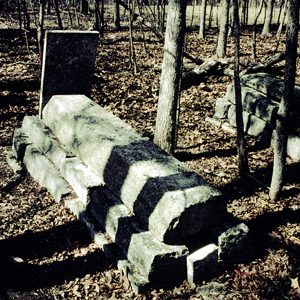calsfoundation@cals.org
Campbell Cemetery
The Campbell Cemetery is located in Randolph County on the north side of the Spring River near Imboden (Lawrence County). It is the only surviving historic resource that is associated with Lawrence County’s first county judge, James Campbell. While it is not known exactly when the cemetery was established, it is believed to have existed by around 1835.
Lawrence County, the second of five counties created out of land that would become the Arkansas Territory in 1819, was established in 1815. At the time, the area was part of the Missouri Territory. While the offices of clerk, sheriff, and coroner were created in 1819, the office of county judge was not created until 1829. By that time, the county government had been moved from Davidsonville to the southern edge of the county at the now extinct town of Jackson. James Campbell, an early settler to the area, was selected as the first county judge in 1829 and occupied the office until 1832. As the county judge, Campbell became an important figure in early northeastern Arkansas.
The cemetery was added to the National Register of Historic Places on May 25, 2006, due in part to it being the burial place of Campbell, who died around 1837. While Campbell’s grave is unmarked, other family members’ graves are identified. Noteworthy vernacular grave markers also contributed to its listing. The cemetery contains four large limestone box tombs with lids carved in the shape of a five-sided coffin. There are also five stone cairns, which are piles of stone on a grave usually associated with Scottish culture. Some graves are simply marked with a chunk of fieldstone.
For additional information:
“Campbell Cemetery.” National Register of Historic Places nomination form. On file at Arkansas Historic Preservation Program, Little Rock, Arkansas. Online at http://www.arkansaspreservation.com/historic-properties/_search_nomination_popup.aspx?id=2173 (accessed October 6, 2021).
Mike Polston
CALS Encyclopedia of Arkansas
 Historic Preservation
Historic Preservation Louisiana Purchase through Early Statehood, 1803 through 1860
Louisiana Purchase through Early Statehood, 1803 through 1860 Campbell Cemetery
Campbell Cemetery 




James Campbell’s daughter Nancy Campbell born in 1803 in Logan County, Kentucky, married Rev. Isaac Brookfield, a Methodist minister from Morristown, New Jersey, in 1823 at the home of her father. They were my great-great-grandparents. Their son Joshua Brookfield was a lawyer and officer in the Confederate army, and was the father of my grandmother, Adelia Brookfield Burns of Jonesboro, who married my grandfather, Joseph Lowry Burns, MD, of Carrol Co., Georgia and Jonesboro. Joshua Brookfield practiced law in Wynne, Arkansas, and owned most of the property where Wynne is situated. He and his wife, Nancy Sanders, are buried in Wynne in the Cogsbill Cemetery.
James Campbell married Ursula Wilson, daughter of John Wilson Sr. and Priscilla Trent Wilson, daughter of Henry Trent III from Cumberland County, Virginia. The Wilsons moved to Logan County, Kentucky, in about 1797. Campbell and Ursula Wilson wed in Logan County, Kentucky, in 1802, and were in the Missouri Territory by 1812 or so. James Campbell was appointed the first sheriff of Old Lawrence County, Arkansas Territory in 1819 by the lieutenant governor of Missouri Territory. Campbell’s plantation was downstream from Imboden about one mile, and fronted on the Spring River, near where the cemetery is located. After retirement as sheriff, he became judge.
His brother-in-law was John Wilson Jr., speaker of the Arkansas House, who killed Col. J. J. Anthony on the floor of the House in Little Rock in a dispute over coyote pelts which resulted in a bowie knife fight.
James Campbell died in 1835 and was buried in the Campbell Cemetery in a cherry wood coffin. Several of his children and his wife are interred in the Campbell Cemetery, plus several other people.
I am a great-great-great-grandson of James Campbell and Ursula Wilson Campbell. I was born in Jonesboro, Craighead County, Arkansas.